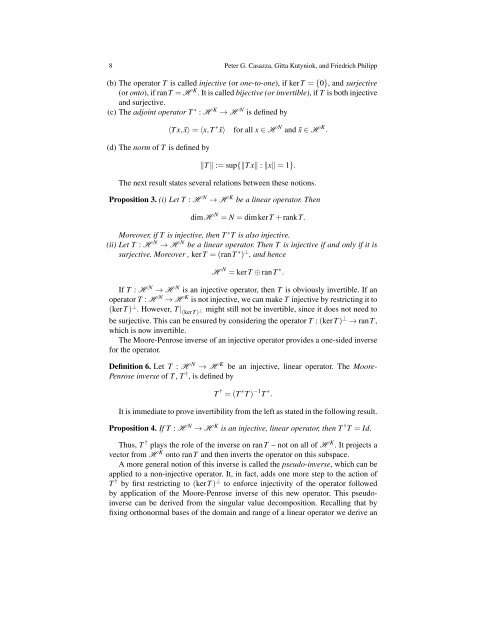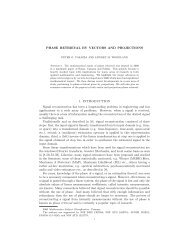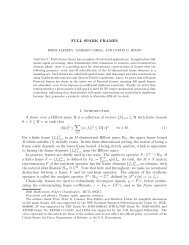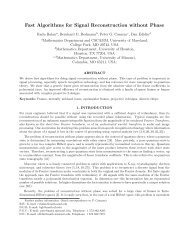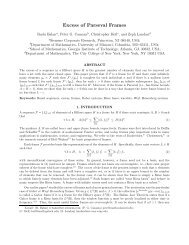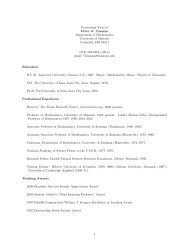Introduction to Finite Frame Theory - Frame Research Center
Introduction to Finite Frame Theory - Frame Research Center
Introduction to Finite Frame Theory - Frame Research Center
Create successful ePaper yourself
Turn your PDF publications into a flip-book with our unique Google optimized e-Paper software.
8 Peter G. Casazza, Gitta Kutyniok, and Friedrich Philipp<br />
(b) The opera<strong>to</strong>r T is called injective (or one-<strong>to</strong>-one), if kerT = {0}, and surjective<br />
(or on<strong>to</strong>), if ranT = H K . It is called bijective (or invertible), if T is both injective<br />
and surjective.<br />
(c) The adjoint opera<strong>to</strong>r T ∗ : H K → H N is defined by<br />
(d) The norm of T is defined by<br />
〈T x, ˜x〉 = 〈x,T ∗ ˜x〉 for all x ∈ H N and ˜x ∈ H K .<br />
‖T ‖ := sup{‖T x‖ : ‖x‖ = 1}.<br />
The next result states several relations between these notions.<br />
Proposition 3. (i) Let T : H N → H K be a linear opera<strong>to</strong>r. Then<br />
dimH N = N = dimkerT + rankT.<br />
Moreover, if T is injective, then T ∗ T is also injective.<br />
(ii) Let T : H N → H N be a linear opera<strong>to</strong>r. Then T is injective if and only if it is<br />
surjective. Moreover , kerT = (ranT ∗ ) ⊥ , and hence<br />
H N = kerT ⊕ ranT ∗ .<br />
If T : H N → H N is an injective opera<strong>to</strong>r, then T is obviously invertible. If an<br />
opera<strong>to</strong>r T : H N → H K is not injective, we can make T injective by restricting it <strong>to</strong><br />
(kerT ) ⊥ . However, T | (kerT ) ⊥ might still not be invertible, since it does not need <strong>to</strong><br />
be surjective. This can be ensured by considering the opera<strong>to</strong>r T : (kerT ) ⊥ → ranT ,<br />
which is now invertible.<br />
The Moore-Penrose inverse of an injective opera<strong>to</strong>r provides a one-sided inverse<br />
for the opera<strong>to</strong>r.<br />
Definition 6. Let T : H N → H K be an injective, linear opera<strong>to</strong>r. The Moore-<br />
Penrose inverse of T , T † , is defined by<br />
T † = (T ∗ T ) −1 T ∗ .<br />
It is immediate <strong>to</strong> prove invertibility from the left as stated in the following result.<br />
Proposition 4. If T : H N → H K is an injective, linear opera<strong>to</strong>r, then T † T = Id.<br />
Thus, T † plays the role of the inverse on ranT – not on all of H K . It projects a<br />
vec<strong>to</strong>r from H K on<strong>to</strong> ranT and then inverts the opera<strong>to</strong>r on this subspace.<br />
A more general notion of this inverse is called the pseudo-inverse, which can be<br />
applied <strong>to</strong> a non-injective opera<strong>to</strong>r. It, in fact, adds one more step <strong>to</strong> the action of<br />
T † by first restricting <strong>to</strong> (kerT ) ⊥ <strong>to</strong> enforce injectivity of the opera<strong>to</strong>r followed<br />
by application of the Moore-Penrose inverse of this new opera<strong>to</strong>r. This pseudoinverse<br />
can be derived from the singular value decomposition. Recalling that by<br />
fixing orthonormal bases of the domain and range of a linear opera<strong>to</strong>r we derive an


